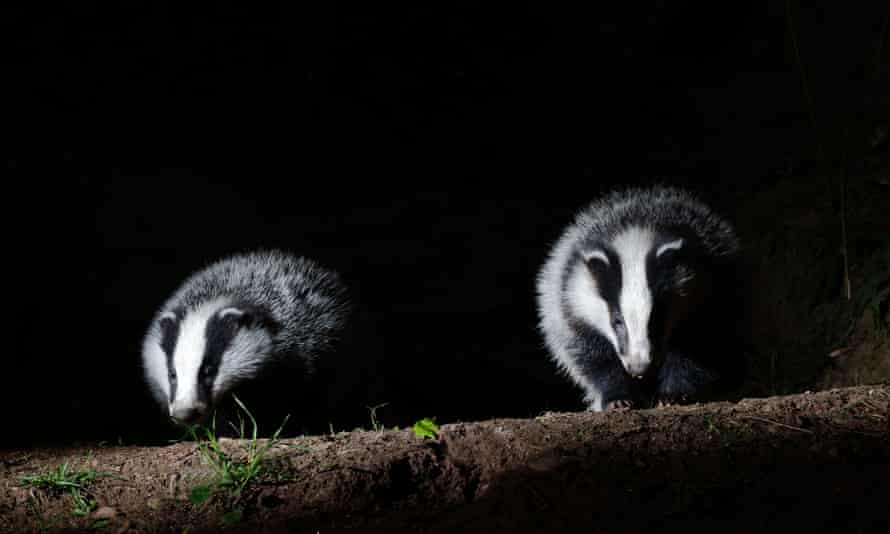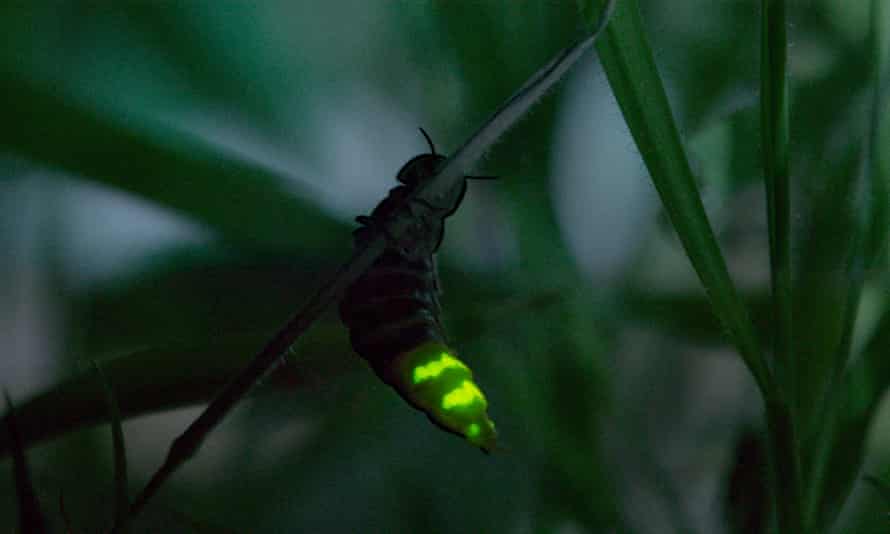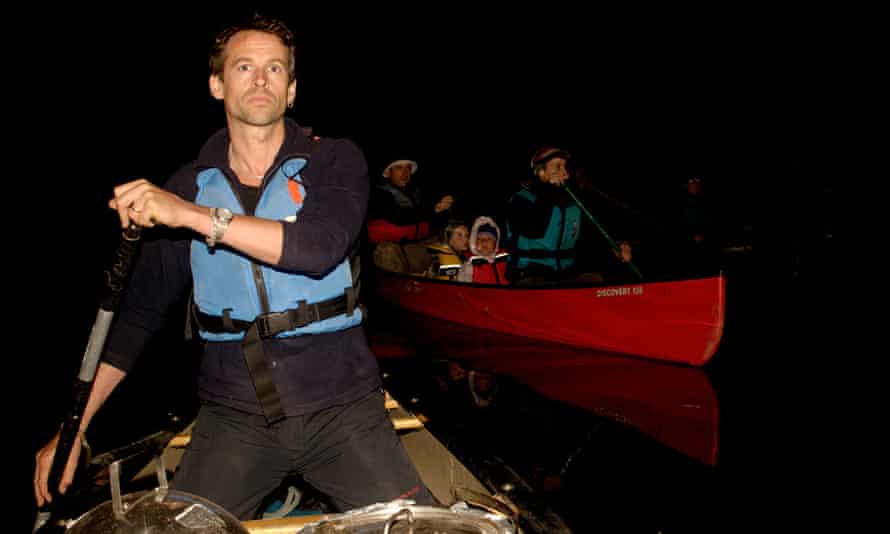To go in the dark with a light is to know the light
To know the dark, go dark. Go without sight,
and find that the dark too blooms and sings,
and is travelled by dark feet and dark wings
Wendell Berry
The night is dark – I mean really dark. The proverbial pitch black, where you can’t see your hand in front of your face. I’m guiding a group of students into the meadows of Andrew’s Wood in south Devon and we have turned off our torches to explore our night vision capacities. There’s cloud cover, and no moon to help, and progress is slow … but exciting. Then, we see it. A ghoulish-green light low down on the ground that draws us closer to look. Or rather behold. There are certain moments of awe and wonder on a night walk that will always mystify and intrigue, and this is one of them.
We crouch and take in the glimmering, shimmering, shining thing. It’s tiny, but oh, so bright. This creature is fiercely defiant of the darkness, producing a lighting effect that captivates us. After some expressions of delight and puzzlement, one of them asks. “What on earth is that?” “It’s a glow-worm,” I say, “though actually it’s not a worm, but a beetle, and this is the female using complex compounds and chemical reactions to emit this light energy in order to attract a mate.”

Then I share the tragic twist in the tale, and the reason why they are so rare. Widespread light pollution means the males can’t navigate to find the females. It’s a situation that affects many species but in terms of our relationship to the dark, things have significantly changed for us too. When was the last time you experienced natural darkness?
Ever since 1880, when Joseph Swan’s home in north-east England was the first to be fitted with his newly invented incandescent electric lighting, natural darkness has been in decline. But by shutting ourselves away in artificially lit homes we’ve become exiled from the enchantment of the night. Under the cover of darkness, our familiar environments are transformed into something mysterious, which means an array of treasures await those who step out of the comforting warmth and lights of home.
There is the nocturnal wildlife that emerges in the dark to escape persecution by daylight, and as a fruitful time to forage: bats, badgers and owls to name a few. But even without them, the nightworld has many attractions. I’ve spent hundreds of nights outside in a long career as outdoorsman, and have been consistently romanced by the night’s seduction. The “otherness” of the dark, the mystery and unknown quality engender excitement and intrigue – and don’t underestimate the impact of simply beholding a confection of stars.
The change in rhythm offers a sanctuary from to-do lists and deadlines, from clock-watching and schedules, and provides a conducive atmosphere for reflection and contemplation. Darkness offers a sort of natural medicine too – releasing melatonin, which helps sleep, acts as an antioxidant and stimulates the immune system.
So perhaps the forthcoming reversion to Greenwich mean time as the clocks go back is the perfect moment to review our relationship with the dark. You don’t need to go out late, join guided walks or have expensive equipment – you just need a sense of adventure, some curiosity, and perhaps a willing accomplice.
Here are my tips on embracing the dark:
Nightwalking

You should of course always be sensible when out exploring at night – maybe gather some confidence by walking with others, or join an organised event introducing people to wildlife or to the night sky. Aim for any areas with natural darkness, away from streetlights. Take a torch by all means and, if possible, use one with a red filter so as not to frighten the animals or compromise your night vision. Try to navigate using your night eyes: if you allow 30 minutes for your vision to acclimatise, you’ll be surprised how much you can see.
Moongazing and star trekking

To watch the moonrise, find a view of the eastern horizon. At full moon this will be simultaneous with sunset. Take binoculars to capture more detail. Viewing the moon this way is breathtaking, and when it is in crescent form, binoculars reveal more of the contours and craters. Consult online almanacs such as space.com or gostargazing.co.uk, to find out about upcoming cosmic events – for example, any planets that may be visible. Mars is close to the moon on 25 November, and Venus is visible in the dawn eastern sky, Jupiter and Saturn in the southern. Winter constellations such as Orion and the Pleiades are also now visible, and the Leonid meteor shower peaks on the night of 17-18 November. There’s always something going on up there, and the clarity of the stars on moonless nights in winter is something to behold. For a star trek experience on Saturday 30 October at Dartington, visit WildWise Star Trek (£7.50 adult, £5 child)
Sit-spot at dusk
Bearing witness to the slow retreat of light is a good mindfulness routine, as well as a good way to acquaint oneself with the dark and its denizens. Just sit and do nothing for 20-30 minutes, paying attention to the rising tide of darkness. You don’t need a wild place: a garden or country park will do, as long as it is away from streetlighting. A mat, and a flask of hot chocolate will make things more comfortable.
Badger spotting

Local wildlife trusts have details of local opportunities. Badgers don’t hibernate and can be seen all year round, albeit less often in the coldest periods. Once you know where a sett is, sit downwind at a safe distance of 20 metres and you may be rewarded with great views of one of night-time Britain’s wildlife celebrities.
Bat-detecting

Before hibernation, bats need to lay down fat reserves, and it’s possible to see them as late as November. Bat enthusiasts abound, and most organise bat walks to get to know these magical creatures. There are over 80 clubs nationwide – details from bats.org.uk.
Owl calling

You may have noticed the increase in contact calls of the tawny owls this autumn, particularly if you live near copses of large trees and woods. They are busy again, defining autumn territories and serenading the neighbourhood. Impersonating their calls can draw a brief response. Visit the more mature deciduous trees in your local area – you’ll hear them if they are there.
Minibeast safari

Even late into the autumn it’s possible to discover invertebrates still active. Gardens are fruitful places to hunt, especially any unkempt areas. Turn over your plant pots, logs and compost heaps to find all sorts of woodlice, millipedes and centipedes – and a few moths like the winter moth are still abroad at night. Take a small torch as you head out to find what lies beneath… There’s always a surprise in store.
Murmurations

Strictly a dusk activity, starling murmurations are one of the most breathtaking wildlife spectacles in the UK. Later in the autumn, migrants from Europe boost resident numbers and where they proliferate, numbering tens of thousands sometimes, the experience is unforgettable. To find the best places to see them visit starlingsintheuk.co.uk
Nightpaddle

A lovely way to experience the night is to drift silently on a river with the current or tide. Unless you are experienced on the water, you’ll need a guide. WildWise Nightpaddle offers night paddles on the River Dart in Devon (from spring 2022) or check out your local canoe club on British Canoeing. Secret Adventures also runs kayaking trips in London, from Battersea to Greenwich (£67, over-18s only).
Campfire time
There’s nothing like a bonfire at night. Its very conducive to community-building, as the atmosphere of warmth, firelight and shadow is special. It facilitates dialogue and, for the creatively inspired, stories and songs. Perhaps use a firepit in a garden – elsewhere you need permission from the landowner to light a fire. Learn some firecraft skills with a bushcraft company such as wildwise.co.uk, woodlandsurvivalcrafts.com or woodcraftschool.co.uk.
Chris Salisbury is the author of Wild Nights Out – the Magic of Exploring the Outdoors at Night (Chelsea Green (£14.99, available for £13.04 at Guardian Bookshop)




